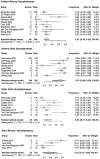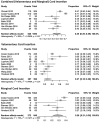Placental architectural characteristics following laser ablation within monochorionic twins complicated by twin-twin transfusion syndrome: A systematic review and meta-analysis of outcomes
- PMID: 38873725
- PMCID: PMC11502458
- DOI: 10.1111/aogs.14891
Placental architectural characteristics following laser ablation within monochorionic twins complicated by twin-twin transfusion syndrome: A systematic review and meta-analysis of outcomes
Abstract
Introduction: Twin-twin transfusion syndrome (TTTS) complicates approximately 10%-15% of all monochorionic twin pregnancies. The aim of this review was to evaluate the placental architectural characteristics within TTTS twins following laser and elucidate their impact on fetal outcomes and operative success.
Material and methods: Five databases were searched from inception to August 2023. Studies detailing post-delivery placental analysis within TTTS twins post-laser were included. Studies were categorized into two main groups: (1) residual anastomoses following laser and (2) abnormal cord insertion: either velamentous and/or marginal or proximate. The primary outcome was to determine the proportion of TTTS placentas with residual anastomoses and abnormal cord insertions post-laser. Secondary outcomes included assessing residual anastomoses on post-laser fetal outcomes and assessing the relationship between abnormal cord insertion and TTTS development. Study bias was critiqued using the Joanna Briggs Institute checklists and Cochrane risk of bias tool. Random-effects meta-analysis was used, and results were reported as pooled proportions or odds ratio (OR) with 95% confidence interval (CI). PROSPERO registration: CRD42023476875.
Results: Twenty-six studies, comprising 4013 monochorionic twins, were included for analysis. The proportion of TTTS placentas with residual anastomoses following laser was 24% (95% CI, 0.12-0.41), with a mean and standard deviation of 4.03 ± 2.95 anastomoses per placenta. Post-laser residual anastomoses were significantly associated with intrauterine fetal death (OR, 2.38 [95% CI, 1.33-4.26]), neonatal death (OR, 3.37 [95% CI, 1.65-6.88]), recurrent TTTS (OR, 24.33 [95% CI, 6.64-89.12]), and twin anemia polycythemia sequence (OR, 13.54 [95% CI, 6.36-28.85]). Combined abnormal cord (velamentous and marginal), velamentous cord, and marginal cord insertions within one or both twins following laser were reported at rates of 49% (95% CI, 0.39-0.59), 27% (95% CI, 0.18-0.38), and 28% (95% CI, 0.21-0.36), respectively. Combined, velamentous and marginal cord insertions were not significantly associated with TTTS twins requiring laser (p = 0.72, p = 0.38, and p = 0.71, respectively) vs non-TTTS monochorionic twins.
Conclusions: To the best of our knowledge, this is the first review to conjointly explore outcomes of residual anastomoses and abnormal cord insertions within TTTS twins following laser. A large prospective study is necessitated to assess the relationship between abnormal cord insertion and residual anastomoses development post-laser.
Keywords: TTTS; abnormal cord insertion; anastomosis; artery–vein anastomosis; laser ablation; marginal cord; placenta; residual anastomoses; twin–twin transfusion syndrome; velamentous cord.
© 2024 The Author(s). Acta Obstetricia et Gynecologica Scandinavica published by John Wiley & Sons Ltd on behalf of Nordic Federation of Societies of Obstetrics and Gynecology (NFOG).
Conflict of interest statement
None.
Figures






References
-
- Benoit RM, Baschat AA. Twin‐to‐twin transfusion syndrome: prenatal diagnosis and treatment. Am J Perinatol. 2014;31:583‐594. - PubMed
-
- Bamberg C, Hecher K. Twin‐to‐twin transfusion syndrome: controversies in the diagnosis and management. Best Pract Res Clin Obstet Gynaecol. 2022;84:143‐154. - PubMed
-
- Shanahan MA, Bebbington MW. Placental anatomy and function in twin gestations. Obstet Gynecol Clin N Am. 2020;47:99‐116. - PubMed
-
- Quintero RA, Morales WJ, Allen MH, Bornick PW, Johnson PK, Kruger M. Staging of twin‐twin transfusion syndrome. J Perinatol. 1999;19:550‐555. - PubMed
Publication types
MeSH terms
LinkOut - more resources
Full Text Sources
Medical

